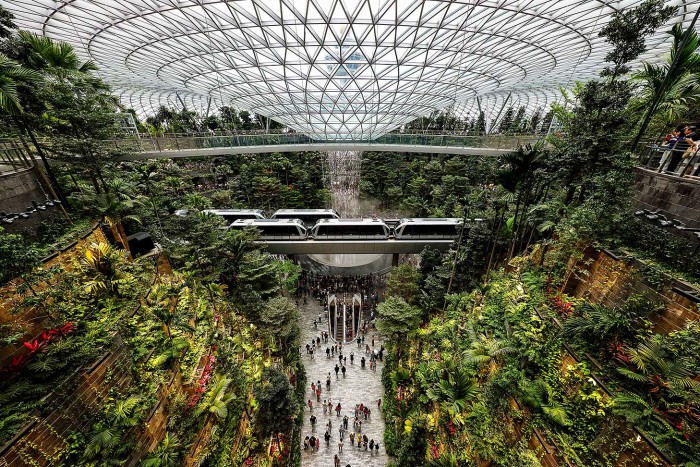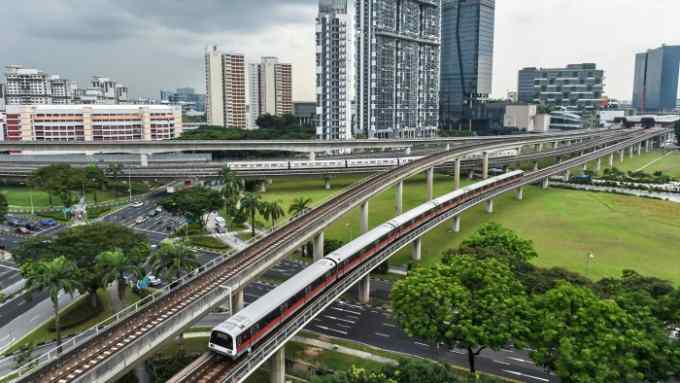Singapore financiers look to put region’s infrastructure on track

Roula Khalaf, Editor of the FT, selects her favourite stories in this weekly newsletter.
Singapore’s Changi airport reinforced its reputation as one of the world’s best airports in April when it opened Jewel, a shopping centre-cum-botanic garden with a 40-metre waterfall — the tallest such indoor feature in the world.
Ever restless, the city state is planning a fifth airport terminal, due to open in 2030, bolstering Changi’s image as a global showcase for Singapore’s ability to deliver urban infrastructure for the 21st century.
In the half-century since independence, Singapore has evolved from a mix of swamp and plantation into a modern state with well-regarded public transport and sanitation systems, while also demonstrating its awareness of the impact of climate change.
Now Singapore is looking to export these skills across south-east Asia, applying its knowhow to the region’s demand for new infrastructure. By 2030 more than 90m people will move to urban areas in Asean (Association of Southeast Asian Nations) countries, the association estimates, creating a belt of “middleweight” cities of between 200,000 and 2m residents.
The Asian Development Bank estimates Asean countries will require $3.1tn by 2030 to cope with rising power, transport, telecoms and water needs. Singapore says such demands can only be met by market financing and bank lending.
“Historically, infrastructure is owned or guaranteed by governments, but governments don’t have an unlimited budget or are unable to provide a guarantee for new projects,” says Seth Tan, executive director of Infrastructure Asia, a Singapore government unit that brings together authorities, investors and industry specialists.
“We’re trying to look forward 20-30 years all the time. We hope to raise the awareness of what the ecosystem can offer,” he says.
In part it is drawn on Singapore’s experiences in moving from low-tech to high-tech manufacturing and into information technology and services.
To that end, Singapore has been an enthusiastic promoter of the Smart Cities Network, in which 26 Asean cities are working jointly to use smart technology in new urban developments.
Singapore also wants to extend its participation in China’s Belt and Road Initiative (BRI), the massive infrastructure project that London-based think-tank the Centre for Economics and Business Research estimates could boost world gross domestic product by $7.1tn annually by 2040. Until now, it has been relatively small.
With both projects, the aim for banks and regulators alike is to exploit Singapore’s financial services industry. As one of Asia’s largest business hubs, it arranges financing for two-thirds of infrastructure projects in Asean countries.
However, authorities also aim to turn infrastructure projects into an asset class for institutional investors such as pension funds, which need regular income streams to fund their long-term liabilities.
The Monetary Authority of Singapore, the central bank and regulator, has explored the idea of converting older, more reliable projects into marketable securities that can be sold.
Last year its adviser Clifford Capital, backed by Singapore’s sovereign wealth fund Temasek, priced Asia’s first such project, in which $458m of debt was issued to institutional investors and listed on the Singapore Exchange. The notes were backed by income streams from 30 marquee projects in Asia and the Middle East.
Banks, which provided the initial lending that allowed the projects to establish a record, also see an opportunity. “Banks are faced with tougher capital rules, and they don’t want to be locked into a project for 30 years. If you can churn that asset more reliably, the system can grow,” says Tony Cripps, chief executive of banking group HSBC Singapore.
Critics say big infrastructure projects such as the BRI lack transparency, and potential investors should be cautious in negotiating with China because of fears that countries would be saddled with unsustainable debt.
Some bankers fear Singapore will miss out on financing deals in the short term because of its stringent standards on project transparency. Earlier this year the two countries agreed to set up an international mediation panel to resolve disputes. In the longer term, Singaporean authorities and businesses are backing its standards to win out.
“Transparency for a project, if it is to realise its full potential, is important — to see that the governance standards are being adhered to,” says Heang Fine Wong, chief executive of Surbana Jurong, a Singaporean infrastructure and development consultancy.
In this respect the government is ready to use its good diplomatic relations with China to push its agenda. Speaking in May, prime minister Lee Hsien Loong warned that “specific projects must be economically sound and commercially viable, and must bring long-term benefits to [the BRI’s] partners”.
“This has not always been the case — some Belt and Road Initiative projects have run into significant problems. Overall, the BRI must be open and inclusive and must not turn the region into a closed bloc centred on a single major economy,” he added.
China’s president Xi Jinping has indicated that Beijing will rethink its approach to the BRI to be more accommodating to other countries.
Ultimately, Singapore benefits if its neighbours become attractive destinations for big global manufacturers looking to relocate their global supply chains out of China to cheaper countries. Samsung, the South Korean conglomerate, for example shifted mobile phone manufacturing to Vietnam.
“Singapore is playing its own role in this story,” says Mr Cripps. “It needs to be friends with everyone. It has only 5m people and it needs to connect with its neighbours.”

Comments